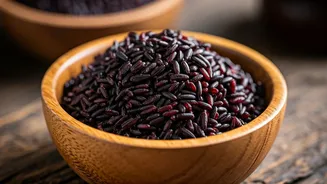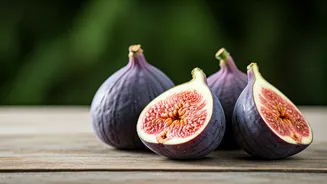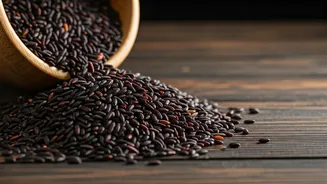Figgy Beginnings
Figs, with their unique texture and subtly sweet flavor, are more than just a treat. They are nutritional powerhouses, offering a wealth of benefits that
contribute to overall health. Beyond their culinary appeal, figs have a rich history, being cultivated for thousands of years in various parts of the world. Different varieties exist, each with a unique appearance and taste profile, making them a versatile ingredient in many cuisines. Whether eaten fresh, dried, or incorporated into various dishes, figs provide essential nutrients that promote digestive health and support cardiovascular function. This article focuses on ways to incorporate figs into your daily life to take advantage of these impressive health benefits. The goal is to provide practical advice and inspiration, so you can enjoy figs in creative and delicious ways while maximizing their impact on your health.
Fresh Fig Delight
Eating fresh figs directly is one of the easiest ways to enjoy their benefits. They are particularly delicious when ripe, offering a soft texture and a burst of natural sweetness. Fresh figs can be enjoyed as a snack, eaten on their own, or added to salads and other dishes. Consider incorporating fresh figs into your breakfast routine by adding them to your cereal, yogurt, or oatmeal. Their mild sweetness and juicy texture complement various grains and dairy products. You could also slice them and add them to a green salad, perhaps with a sprinkle of feta cheese and a light vinaigrette. When choosing fresh figs, look for those that are plump and slightly soft to the touch. Avoid those that are bruised or have any signs of mold. Ensure you wash the figs gently before consuming them to remove any dirt or debris.
Dried Fig Wonders
Dried figs offer a concentrated source of nutrients and can be a convenient way to enjoy figs throughout the year. The drying process intensifies their flavor, making them a sweet and chewy treat. They are an excellent source of fiber, which is crucial for maintaining digestive health. Dried figs are also rich in minerals like potassium and iron. When using dried figs, incorporate them into trail mixes, energy bars, or granola. Add them to your baked goods, such as cookies or muffins, for natural sweetness and added texture. Use them as a topping for your breakfast cereal or as an ingredient in your savory dishes. If you find them too dry, soak them in warm water or juice for a few minutes before eating to soften them up. Be mindful of portion sizes, as dried figs are calorie-dense.
Fig & Yogurt Pairing
Combining figs with yogurt creates a wholesome and balanced snack or breakfast option. The probiotics in yogurt support gut health, while figs provide fiber and other essential nutrients. This combination aids digestion, increases satiety, and provides a good source of energy. Choose plain yogurt, whether it is dairy-based or a non-dairy alternative like coconut or almond yogurt. Adding fresh or dried figs provides natural sweetness, reducing the need for added sugars. In addition to improving the taste, the combination is also incredibly versatile, offering an easy way to include more fruits in your daily diet. Combine chopped figs with yogurt and a sprinkle of nuts and seeds for a filling and nutritious meal. Experiment with different types of yogurt and fig preparations to find your favorite combinations.
Fig Smoothies
Adding figs to your smoothies enhances their nutritional value and flavor profile. Figs blend well with other fruits, vegetables, and liquids, making them a versatile ingredient in various smoothie recipes. Figs provide fiber, antioxidants, and a natural sweetness that complements other ingredients. Start with a base of almond milk, coconut water, or another liquid of your preference. Combine fresh or dried figs with fruits such as bananas, berries, or mangoes. Add a handful of spinach or kale for an extra boost of nutrients, or throw in a scoop of protein powder for enhanced satiety. To enhance the flavor and nutrients, include some nuts or seeds. Blend everything until smooth, adjusting the consistency as needed. The sweetness of the figs and the other ingredients should reduce the need for added sweeteners.
Fig & Oatmeal Power
Figs can transform a simple bowl of oatmeal into a more nutritious and satisfying meal. The fiber in figs helps regulate digestion, while the combination with oats provides sustained energy. This is a quick and easy way to add natural sweetness and texture. Prepare your oatmeal as usual, using water, milk, or a non-dairy alternative. Add chopped fresh or dried figs towards the end of the cooking process, allowing them to soften slightly. Consider including other toppings such as nuts, seeds, cinnamon, or a drizzle of honey or maple syrup for enhanced flavor and nutrition. This makes for a great start to your day or a nourishing snack that is easy to prepare and can be customized to your personal preferences. The added fiber and nutrients can help regulate blood sugar levels and keep you feeling full for longer.
Fig in Salads
Figs add a touch of elegance and a burst of flavor to salads. Their unique sweetness and texture contrast well with other salad ingredients, creating a balanced and satisfying dish. They are versatile, and can be incorporated into various types of salads, from simple green salads to more complex combinations with cheeses and nuts. Slice fresh figs and add them to a bed of mixed greens. Include other ingredients such as goat cheese, walnuts, and a balsamic vinaigrette for a gourmet touch. They work well in salads with grilled chicken or fish. For a lighter salad, combine sliced figs with arugula, prosciutto, and a drizzle of olive oil and a squeeze of lemon juice. The addition of figs to salads not only elevates the taste but also boosts the nutritional value.
Fig & Cheese Delight
The pairing of figs and cheese is a classic combination that creates a delightful contrast of flavors and textures. The sweetness of figs complements the savory and creamy notes of different types of cheese, making them a perfect appetizer or snack. Figs pair exceptionally well with cheese varieties such as goat cheese, brie, blue cheese, and even cheddar. Arrange slices of fresh or dried figs on a platter, and serve them alongside your favorite cheese. You can drizzle honey or balsamic glaze over the figs and cheese for added flavor. For a more elaborate appetizer, try wrapping figs with prosciutto and serving them with a dollop of goat cheese. This simple combination is perfect for parties or a casual snack.
Fig in Baking
Figs can be incorporated into a variety of baked goods, adding natural sweetness, moisture, and texture. Whether fresh or dried, figs enhance the flavor and nutritional profile of cakes, muffins, cookies, and bread. Use chopped dried figs as a substitute for chocolate chips in cookies or add them to your muffin batter for a delightful twist. For cakes and breads, incorporate pureed or chopped fresh figs. When baking with figs, reduce the amount of added sugar as they already contribute significant sweetness. Experiment with different spices like cinnamon, nutmeg, and cardamom to enhance the flavor of the baked goods. Baking with figs provides a healthy and delicious way to enjoy your favorite treats.
Fig Infusions
Figs can be used to infuse water, vinegar, and oils, adding subtle sweetness and flavor to your culinary creations. Infused fig water makes a refreshing drink, while fig-infused vinegar and oils add depth to your dressings and marinades. To make fig-infused water, add sliced fresh or dried figs to a pitcher of water and let it sit in the refrigerator for a few hours. This will infuse the water with the natural sweetness and flavor of the figs. Use fig-infused vinegar or oil to dress salads, marinate meats, or add flavor to roasted vegetables. Infusing figs is a simple way to elevate your culinary creations. Always use high-quality ingredients, and adjust the amount of figs and the infusing time according to your preferences.













